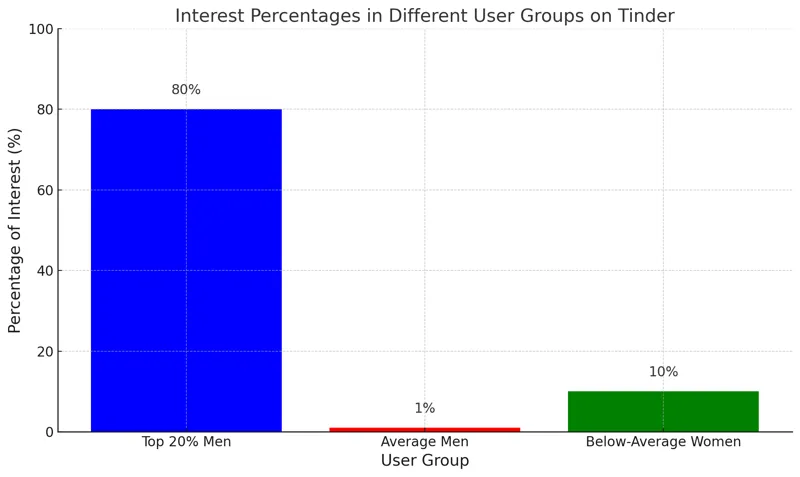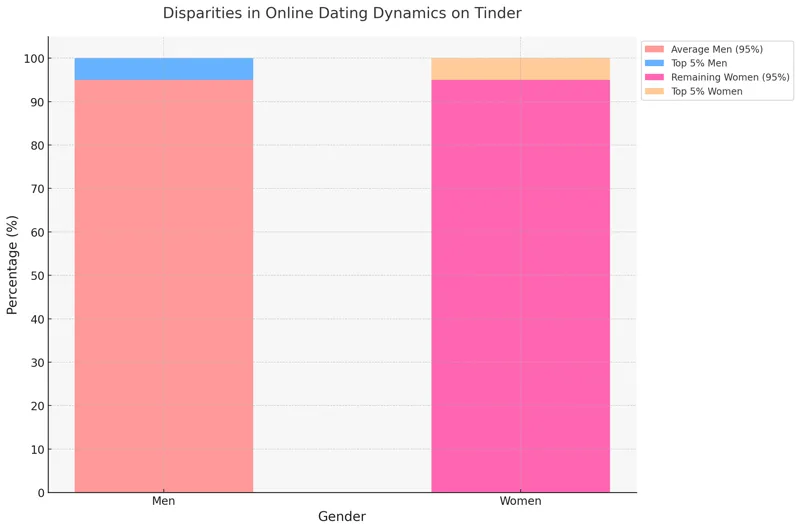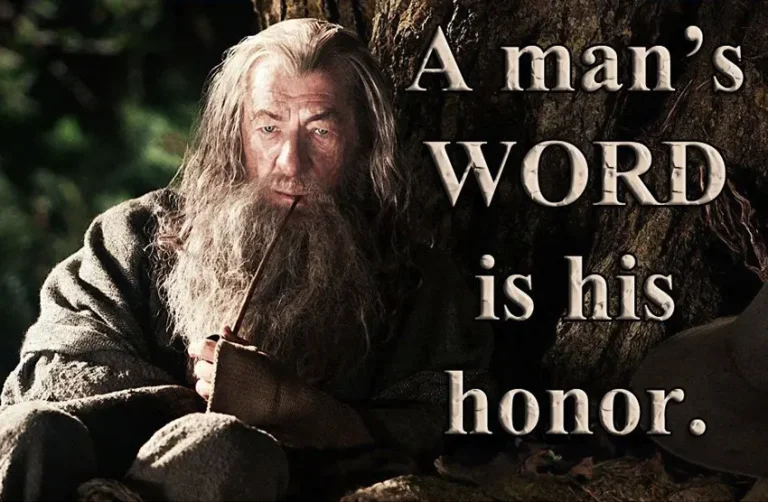Skewed Dating Dynamics And Gender Ratios On Online Dating Platforms Like Tinder
There is an ongoing debate about dating dynamics and gender ratios on online dating platforms like Tinder. Drawing from various perspectives, it presents the argument that a disproportionately small percentage of men receive an outsized share of interest and attention from women users.
Specifically, the text references the “95/5 rule” – the claim that 95% of women are primarily interested in the top 5% of the most attractive men. This is supported by data from Tinder showing a severe imbalance in the number of “likes” received by male and female users. According to one analysis, an average looking man can expect interest from less than 1% of women, compared to much higher reciprocation rates for even below-average women.
The text explores several implications of this phenomenon. One is that average and below-average men face extreme competition on platforms like Tinder, with little hope of standing out. Another is that women, flooded with choice, become overly selective and “trade up” frequently, pursuing the most attractive men even if they offer no commitment. This dynamic also influences real world interactions, with women avoiding settling down in hopes of ultimately securing one of the most desirable men.
There are dissenting perspectives. Some note that individual tastes vary, so blanket ratios don’t apply perfectly to all users. Others argue that factors like personality, confidence and compatibility allow many average men to find partners, especially as priorities change with age. But overall, the text indicates that modern dating platforms amplify pre-existing mating behaviors and norms, making partner selection even more imbalanced.
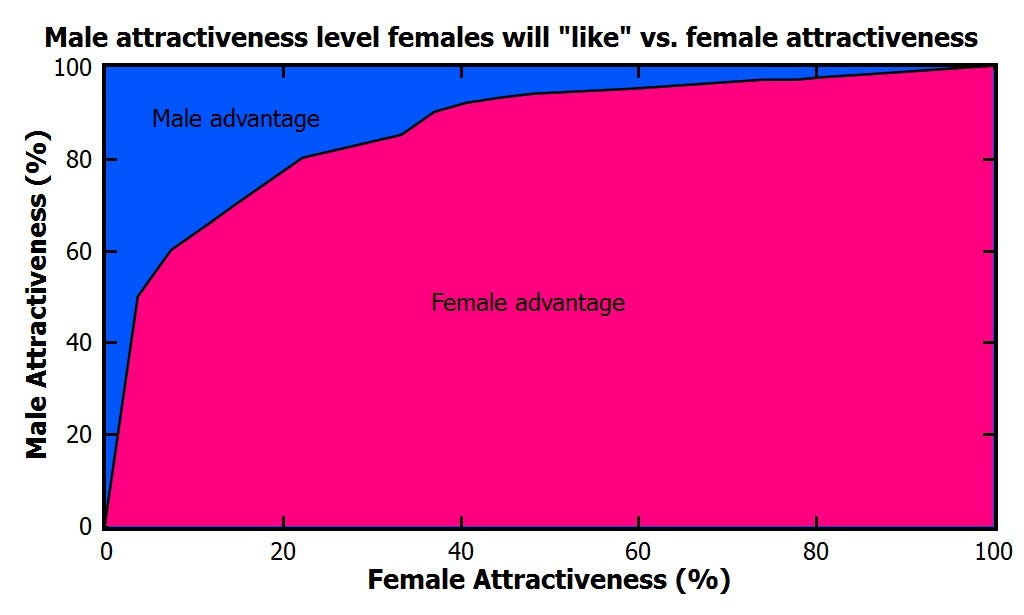
Evolutionary psychology offers one explanation
What accounts for this imbalance between a small group of highly desired men and a large majority competing for very limited affection and attention?
Evolutionary psychology offers one explanation. Researchers in this field argue that women are biologically wired to be very selective, devoting their limited reproductive capacity to the most genetically fit mates. Meanwhile, men are programmed to be less discriminating, maximizing their chances by seeking quantity over quality. Dating apps, with their endless profiles and no consequences for mass swiping, may allow men and women to express their innate mating strategies more freely.
However, many challenge this notion, arguing that learned cultural and social factors also shape modern dating behaviors. For example, persisting gender roles socialize women to be passive and reactive rather than active pursuers. The stigma against female promiscuity also likely motivates women to be extra selective. Meanwhile, men still feel pressure to conform to the stereotype of the aggressive suitor.
Other factors potentially contributing to the imbalance include the design of the apps themselves. Features like endless profiles and instant messaging may encourage a “shopping” mentality, where users always think they can do better. Algorithms that limit visibility or elevate the most popular users also reinforce the status quo. And the anonymity online dating provides likely leads to ruder or more dismissive behavior.
So what can be done to create a better environment? Dating apps could tweak their algorithms to showcase a more diverse range of users and limit instant communication. Users should be more proactive communicating their needs and priorities in their profiles rather than just reacting to others. Society should also continue working to break down rigid gender norms that box men and women into adversarial mating postures online and off. More open and constructive communication between the sexes may help close the gap.
Interest Percentages in Different User Groups on Tinder (Updated)
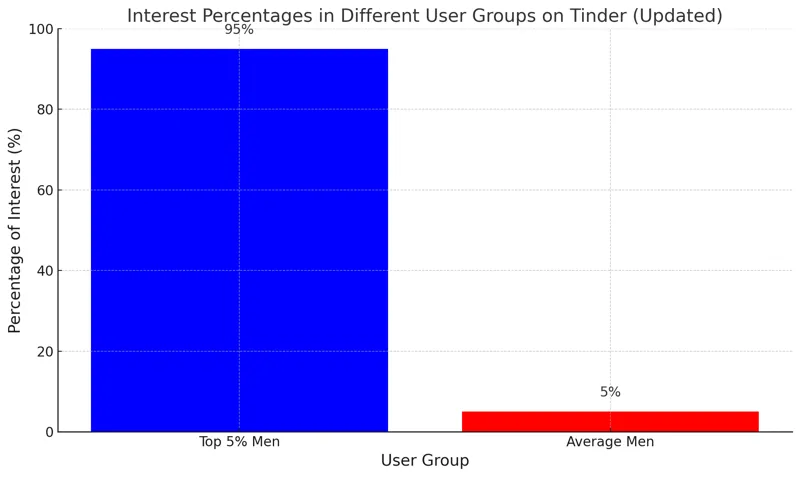
The collision between gendered mating behaviors
While the root causes of dating app gender dynamics may be complex, the real-world impact on both women and men is quite clear.
For women, especially average and below-average looking women, dating apps seem to offer an irresistible abundance of potential matches. The sheer number of men to choose from feeds into a “trading up” mentality where women become conditioned to always think something better is just a swipe away. This hyper- selectivity means excessive nitpicking on even trivial negatives and a refusal to give the majority of matches a fair chance.
The result is a paradox of choice – women become overwhelmed and indecisive, unable to move any conversation offline because they are paralyzed by the illusion of limitless options. This constant searching for perfection leaves many perpetually dissatisfied and alone. As they age, the prospect of settling for an average man they would have once ignored becomes depressing.
For the majority of men who receive little attention, the experience bruises self-esteem and encourages an embittered view of the opposite sex. Many express resentment at the effort required for even slight female interest. Some turn to dishonest tactics like spamming copy-pasted messages. Others simply withdraw from dating apps altogether. Those who stay face a grinding discouragement knowing the odds are so heavily stacked against them.
But even the small minority of highly desired men do not have an ideal experience. They must deal with a firehose of interest and expectations from countless matches. But with so many options vying for their affection, they feel little incentive to make meaningful connections, seeing matches as interchangeable. Some take advantage by pursuing only casual encounters. Others feel emotionally exhausted by trying to give each match appropriate attention. Very few find the sort of fulfilling long-term relationship they may also crave.
So in different ways, dating app gender dynamics lead to dissatisfaction for both women and men across the spectrum of desirability. The products designed to facilitate connections often achieve the opposite effect. And interactions are tainted by resentment, bitterness, and mistrust between the sexes.
Fundamentally, both genders want similar things from dating apps – an efficient path to finding meaningful compatibility. But the collision between gendered mating behaviors and modern app features too often thwarts that goal. Altering core dynamics will require reducing excessive selectivity while expanding visibility beyond just the most outwardly attractive. A healthier balance can create an environment of enhanced understanding between men and women.
Relationship Dynamics of the Top 5% of Women with the Top 5% of Men on Tinder
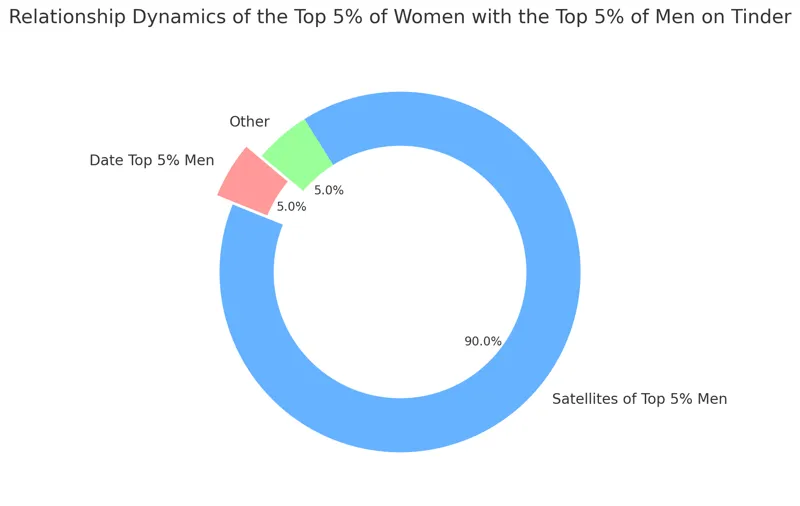
Technology alone cannot overcome deeply rooted social factors
If current dating app gender dynamics lead to dissatisfaction for users across the desirability spectrum, how can platforms begin to shift toward healthier balanced engagement between men and women?
One approach is recalibrating the visibility algorithm to ensure a wider variety of users in both genders get reasonable exposure. This prevents the same small subset of men soaking up a disproportionate share of attention. While apps want to feature conventionally attractive users to drive engagement, they can blend in more diversity.
Relatedly, apps can cap the number of potential matches presented each day. Women in particular complain of being overwhelmed by excessive choice. Limiting daily matches requires users to be more thoughtful in their selectivity rather than endlessly chasing the illusion of someone better.
Platforms should also rethink features that encourage rapid-fire superficial judgments. Instant messaging allows little time to evaluate nuanced profile information before a snap decision. Similarly, swipe-based evaluations prime users to make hasty attractiveness-based judgments. Adding friction like profile quizzes or mutual opt-in matching can shift focus toward substantive compatibility.
However, technology alone cannot overcome deeply rooted social factors that shape modern dating dynamics. Users must also take more accountability for their mindsets and behaviors.
For example, women have to recognize that chasing an unrealistic standard of ideal male beauty is neither fulfilling nor efficient. Prioritizing more well-rounded compatibility can open options. Rather than endlessly waiting to be impressed, they can also initiate contact themselves more often with matches they are interested in.
Meanwhile, men have to understand that harassing or demeaning women is counterproductive. Thoughtfully crafted, personalized messages conveying genuine interest lead to better outcomes. Men should also expand their own selectivity rather than desperately chasing every potential match.
Both genders should focus on quality over quantity in their matches and interactions. Patience and open-mindedness is required to uncover compatibility that may not be immediately obvious based on superficial impressions alone.
Wider societal attitudes also play a role. Rigid gender norms often unconsciously shape behaviors like men competing for sexual quantity and women passively screening for elite male status. Dismantling these outdated perspectives can alleviate adversarial mating mindsets.
There are no instant solutions. However, with targeted reforms by dating platforms combined with greater user accountability and societal progress, today’s unhealthy dating app dynamics can gradually shift toward more balanced engagement. This will require patience, empathy and seeing the humanity in both the most and least conventionally desirable users. Incremental change is possible if priorities become facilitating meaningful connections rather than addictively empty frictionless matching.
Online Dating Disparity: Distribution of Male Interest Across Female Users on Tinder
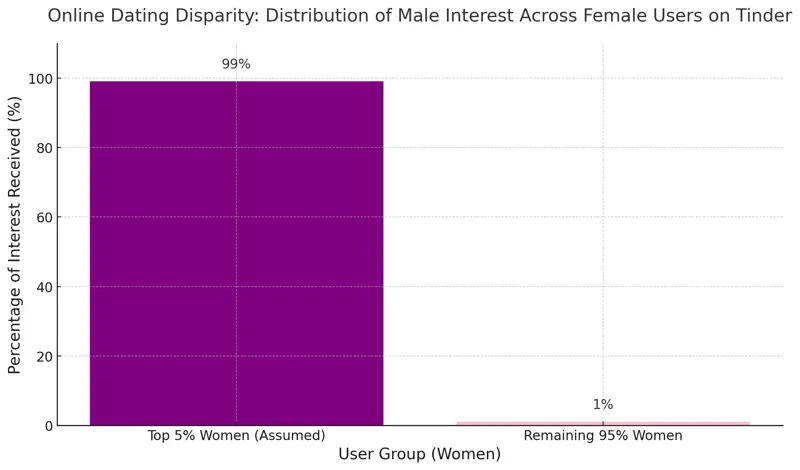
Refine features with an eye toward healthy incentives and visibility
If the goal is balancing gender dynamics on dating apps, where should responsibility lie – with the platforms themselves or the individual users? Strong cases can be made on both sides.
Some argue that reforming fundamental app features and algorithms alone can create positive change. For example, if visibility and messaging were controlled to promote quality over quantity, users would organically shift their behaviors, regardless of underlying attitudes. Just as bad app design intensifies negative tendencies, better design can incentivize healthy interactions.
Advocates of this view point to studies showing how technology and environment shape human behavior far more than inherent personality or morality. Most people conform to the patterns and incentives the system provides. So placing the onus for change on users’ choices ignores external conditioning. Reform the systems shaping choices, and individual habits will improve.
However, others counter that human nature has core elements no app can totally reshape. Innate mating motivations evolved over millennia and will override any induced behavioral nudges. No algorithm will make users act counter to their own perceived self-interest.
From this perspective, putting the burden on apps lets users off the hook for their own mindsets and actions. Things like kindness, empathy and respect are human values requiring moral effort, not simple app design choices. Users unwilling to take responsibility for ethical conduct will always find ways to circumvent system constraints.
So sustainable improvement requires individuals committing to personal development and intergender understanding that penetrates deeper than interface tweaks. Users of both genders must challenge knee-jerk assumptions and combat negativity toward the opposite sex. Rather than quick technological fixes, the solution lies in moral leadership and consciousness raising.
Of course, the two approaches are not mutually exclusive. Shared responsibility likely works best. Dating platforms should continually refine features with an eye toward healthy incentives and visibility. But users must also reflect on how they can contribute to collective progress through greater compassion and taking the initiative to understand different perspectives.
Blaming others or waiting for change from above will not suffice. Lasting cultural shift requires combining structural reforms that model positive patterns with individual personal growth that internalizes those patterns as values. Both dating app companies and users should see themselves as partners in nurturing an environment where all genders feel empowered to seek meaningful compatible connections, not just superficial quick matches.
With joint commitment to improvement, today’s unhealthy app dynamics can transform into something far more positive for everyone. But it will take willingness to experiment and adapt from platforms and readiness for honest self-examination from users. Putting in this effort offers substantial upside – healthier intergender relations online and off.
Disparities in Online Dating Dynamics on Tinder
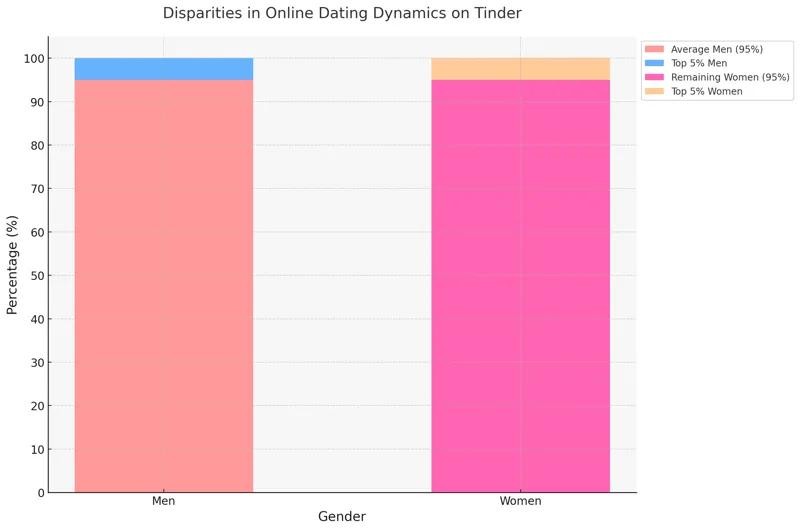
Acknowledging that many average men have much to offer
The debate around dating app gender dynamics speaks to a broader discussion of evolving male-female relations in the modern era. Power imbalances that favored men for generations have eroded in many spheres, creating disorientation about normative roles and behavior. Dating apps represent a high-profile arena working through this transition in real-time.
Some men lament the loss of historical privileges like unilateral courtship initiative and abundant female attention. But most recognize the positives of dismantling outdated gender restrictions that also confined men. The question is how to adapt attitudes and behaviors to align with contemporary realities.
For many men, that involves abandoning lingering senses of entitlement or resentment and developing empathy toward women’s dating experiences. It means recognizing that listening, emotional availability and collaboration better serve long-term relationship goals. Rising above bitterness and constructively working to become one’s best self is both ethically sound and pragmatically wise.
At the same time, women must resist holding men to unrealistic standards inherited from fictional tropes and conventional gender frameworks. Judging men as inadequate for failing to perfectly match fantasized ideal types leads to needless frustration. Appreciating men’s complexity as fellow humans rather than critically assessing their utility as partners or status objects is the healthier mindset.
This also means acknowledging that many average men have much to offer in areas beyond the superficial. Holding others to high standards is admirable, but projecting rigid expectations onto them benefits no one.
Both genders should grant each other grace. Developing genuine curiosity about the other’s experiences and perspectives can replace blind judgment. If women avoid reflexively seeing men as adversaries and men avoid seeing women as adversaries, connection emerges.
With conciliatory attitudes, the noise of antagonistic gender politics fades. The focus shifts away from blaming each other for playing the terrible hands dealt by history. Instead, vision elevates to collaboratively reshaping social systems and norms to support mutual flourishing. Righting past wrongs becomes less about punitive reparations than creating opportunity.
These aspirations align with the highest ideals of modern enlightened societies – equality, empowerment, compassion. But change remains difficult when residual privileges and grievances distort perceptions of self-interest. Rising above these requires magnanimity and wise discernment of what true progress demands.
If modeled in digital spaces like dating apps, such enlightened values and mindsets can spread more broadly. Technology creates possibilities to architect new social realities aligning individual behaviors with collective aspirations. Users willing to embrace this potential can accelerate progress.
With courage and moral imagination, we can build fairer systems that expand possibility. With openness and good faith, we can foster understanding that dissolves division. The path forward has obstacles but our shared destination is profoundly hopeful – a society of mutual care and partnership between men and women. Dating apps offer merely one sphere to manifest this vision, but an important one to watch closely as we chart the course ahead.
Interest Percentages in Different User Groups on Tinder
